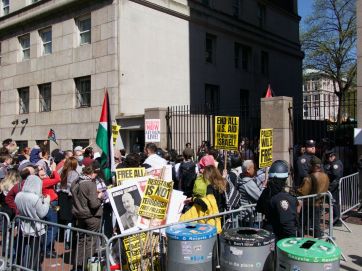The movement to impose a boycott on Israeli universities, to get colleges to divest from Israeli companies, and to impose other sanctions on Israel—the BDS movement (boycott, divest and sanction)—was launched in 2005 by a collection of Palestinian organizations. Over the last decade it has gathered significant support in American higher education, but the enthusiasm of some American academics for the cause didn’t attract much attention outside the academy until the vote by the American Studies Association (ASA) in December 2013 to join the boycott.
That vote shocked many who had not yet heard of the US Campaign for the Academic & Cultural Boycott of Israel. The National Association of Scholars called on the ASA not to join the boycott. And when the ASA went ahead with it, some colleges and universities responded by dropping their institutional memberships in it. One consequence of the furor was a series of decisions by other scholarly associations, including the Modern Language Association, to reject proposals that they also join the boycott.
Since then, the BDS movement has been less prominent in American higher education but it has not gone away. Last week the New School held a two-day conference, “Sanctions and Divestments: Economic Weapons of Political and Social Change.” Nimer Sultany, lecturer in public law at the University of London, who is Palestinian and one of the international leaders of the BDS movement, argued that BDS is a promising tool to advance the goal of returning “all Palestinian lands” to Palestinians and to “reverse Israeli colonization.” Todd Gitlin, the 60s radical who is now the chairman of the Ph.D. program in Communications at Columbia University,opposed BDS on the grounds that its stated goal is “too broad.”
Vagueness generally helps the proponents of BDS. At the New School event, Sultany refused to be pinned down as to what exactly its goal might be. The eradication of Israel? He wasn’t ruling it out, but neither did he own it.
This reticence about goals may help proponents of the movement to draw in supporters who feel sympathy with dispossessed Palestinians but haven’t thought very much about the implications of the movement’s broad claims. When those claims come into sharper focus, campus support dwindles.
That lesson was displayed on May 2, when students at Bowdoin College in Brunswick, Maine voted down a proposal to support the boycott. With 1,619 students voting, only 228 voted in favor of the boycott, and 1,144 voted against it. (247 abstained.) The students showed collective wisdom, and in this case they were influenced by Bowdoin’s out-going president, Barry Mills, who in 2014 issued a strong statement rejecting the boycott movement.
The National Association of Scholars pays special attention to Bowdoin College. Our 2013 study, What Does Bowdoin Teach? How a Contemporary Liberal Arts College Shapes Students, picked out Bowdoin to serve as a representative institution—one that was small enough to study in depth, but also one whose strengths and weaknesses are widely shared by other elite liberal arts colleges. In that vein, we took a critical view of the readiness of the Bowdoin administration and the students to embracefashionable progressive causes.
In this case, however, Bowdoin has demonstrated a more thoughtful and deliberative side.
The idea of getting Bowdoin to boycott Israel had come up before. Mills’s 2014 statement was a response to an earlier round of advocacy. A new round began this spring and eventuated in a petition circulated in April by the Students for Justice in Palestine (SJP). According to one of the group leaders, the goal was “to isolate parts of the Israeli state apparatus that are normalizing the maltreatment of Palestinians and abuses of their human rights.” The petition got enough student signatures for a student-body-wide referendum. The success of the petition drive, however, alarmedother students who organized a counter campaign.
The Bowdoin Orient, the student newspaper, quoted students as saying that they didn’t know enough about the conflict in order to vote with a clear conscience. This is noteworthy in that it means that students did not take the boycott as the default position. They did not just assume that the case for the BDS movement was right. Other students voiced more particular objections such as their preference for a two-state option. Still others complained that the boycott “threatens academic freedom,” especially the “free exchange of ideas” about the conflict itself.
All of this is encouraging—encouraging that a college community that has often fallen into lockstep conformity on political issues and shown very little interest in allowing a diversity of opinions to flourish re-discovered the value of open debate.
It is especially encouraging because we are in a strange moment in American higher education: a moment in which intellectual freedom seems terribly imperiled. The rhetoric of “rape crisis”; the insistence that there is a “climate consensus” that obviates the need to hear from skeptics; the post-Ferguson hyping of the idea that America uses violence to maintain a racial hierarchy—these and many more pronouncements have fostered a campus climate across the country in which students congratulate themselves for shutting down discussion, dis-inviting speakers who might disagree with prevailing opinions, and attacking thosefew students who stray from the new orthodoxies. Intimidation is the hottest campus trend.
Bowdoin is far from immune to these disorders. It is not a place where intellectual freedom generally flourishes. But as we showed in What Does Bowdoin Teach? there is another, older, and better Bowdoin. It is reassuring to see the college in this instance find its better self. And if Bowdoin is indeed representative of elite higher education, perhaps the vote on May 2 is a sign of a broader recovery in American higher education. The BDS movement is an ugly retreat from academic and intellectual freedom. It is heartening to see it beaten back so decisively in a place where its proponents might well have expected an easy win.
This article originally appeared at Minding the Campus on May 7, 2015.













